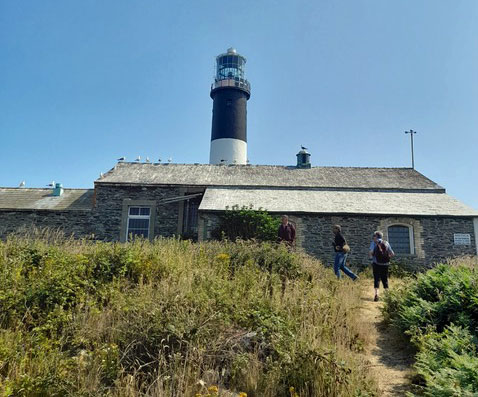In the middle of the recent heatwave, members of Bangor Historical Society relished a boat trip to the Copeland Islands on the Ocean Crest, skippered of course by Brian Meharg MBE. Emerging out of the morning mist, the islands could have been in the Mediterranean! The boat first passed the west end of the large island, before coming close to Bird Island, otherwise known as Old Lighthouse Island. It was explained that the main island was inhabited for centuries, with the most familiar surnames being generations of Cleggs and Emersons. Thomas Raven’s 17th century maps clearly show cottages on the island. It seems the last residents were a young couple around 1948 who tried to start an early version of The Good Life but were finally defeated by the exposed terrain and lack of electricity and running water.

Society Chairman Ian Wilson explained that the name ‘Copeland Islands’ has two rival explanations, firstly from a late 12th century Anglo-Norman landowner on the mainland, de Coupland (of Ballycopeland ) and also it’s theorized that the name may derive from the Old Norse for merchants’ islands kaupmanneyjar from the Viking era when their ships were regularly trading to and from their settlements at Dublin and the Isle of Man. Perhaps the islands were a convenient depot for storing goods.
Bird Island is of course the home of a flourishing observatory. A highlight of the outing was seeing very close-up dozens of puffins, and being near enough to the rocks to see their nests in burrows above the high-tide mark. Puffins have only begun breeding here in recent years, following a carefully staged plan of introduction. The bird most associated with the island is the Manx Shearwater, as Northern Ireland’s only colony is here. The Copelands are geographically very well placed to observe migrating and arriving birds. Our skipper pointed out remains of the first Copelands lighthouse, an 18th century building which replaced a large brazier, and the keeper’ s quarters. Just beside them is the accommodation for the present-day ornithologists. Discussion resulted regarding the difficulty of landing the large tonnage of coal needed to power these early lights.

As the tide was high, the Ocean Crest was then skilfully manoeuvred alongside the little quay which serves the lighthouse on Mew Island. The lighthouse became fully automatic and unmanned in 1996 but some of our party remembered landing to be greeted by the keepers, who maintained a unique lifestyle round the Irish coast. Even on the flat and windswept Mew Island they were able to cultivate a vegetable patch. It was on this island that the slave ship Enterprise was wrecked in 1803 returning from the Caribbean. Large amounts of silver were raised by pioneer divers the Deane Brothers in the 1830s, and even today a terrace in Whitstable, Kent, which they built with some of the profits, is known as Dollar Row.
Mew Island light dates from 1884. With increased steam communication and the rise of the port and shipyards of Belfast, a lighthouse more powerful and strategically sited than the existing one was essential. In recent years an LED solar-powered light has been installed, and the old optic now stands in Titanic Quarter, Belfast, on the public walking route from the Titanic Experience to HMS Caroline. Members could recall the deep note of the Copelands fog signal, now no more, but we watched two ferries passing very close sounding theirs.
The sea mist had lifted and brilliant weather was enjoyed on the return trip to Bangor. Thanks goes of course to Brian and his faithful crewman Ian!
